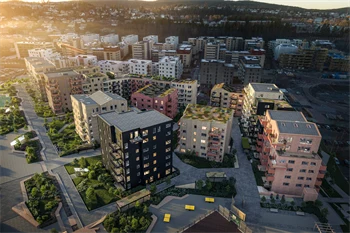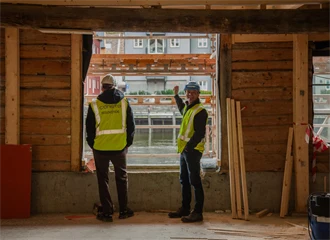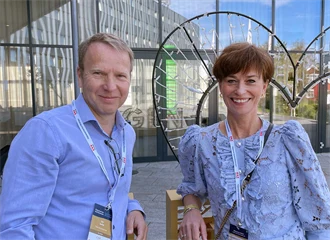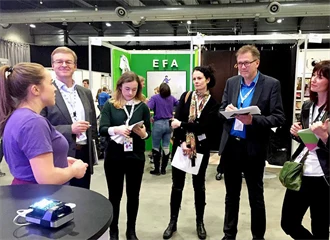Ambitious cuts in greenhouse gas emissions
One of our primary goals is to cut scope 1 and 2 greenhouse gas emissions by 60% by 2030 (see fact box). By 2050, we will have net zero emissions.
By then, all renovations must be carried out in accordance with the EU taxonomy, a classification system for what is considered sustainable, drawn up from the EU’s climate strategy.
On the way with Science Based Targets
We are continuously working to improve the data basis for our carbon accounting. Among other things, we have a goal of setting Science Based Targets, an international framework that ensures that the company’s climate goals are in line with the Paris Agreement. This requires us to map scope 3 to a much greater extent than we have done as per 2024.
A dedicated energy department is central to cut emissions
Compared to many other real estate players, we in the Thon Group are in a unique position to cut our own emissions more quickly. This is because we also operate many of the properties we rent out or build and sell.
Parallel to the operations department, we have created a dedicated energy department that works to make us better every day.
Energy and waste have been central topics for the group since we conducted our first materiality analysis in 2016. It showed that this is where our biggest emissions come from.
What are scope 1, 2 and 3?
- The Thon Group uses the GHG protocol (Greenhouse Gas Protocol) to divide emissions into different scopes.
- Scope 1 is emissions that the company itself has operational control over, such as emissions from transport and stationary combustion.
- Scope 2 is emissions from purchased energy, such as electricity, district cooling and district heating.
- Scope 3 is indirect emissions from the production and transport of purchased goods and services, as well as emissions linked to end users of sold goods and services.
Sources: ghgprotocol.org and Energy and Climate

BREEAM – environmental certification of new and older buildings
The construction industry accounts for around 40% of the world’s greenhouse gas emissions. For the Thon Group, which primarily operates in the real estate and hotel business, this is where there is the greatest opportunity for a significant change.
We are in the process of environmentally certifying new and older buildings – shopping centres, hotels, commercial premises and residential buildings – in accordance with the international certification scheme BREEAM In-Use. The Energy Department has developed good procedures for certification and recertification.
By 2030, our goal is for 60% of our shopping centres and hotels to be certified as "Very Good", which is the third out of a total of five certification levels at BREEAM In-Use.
Green areas and biodiversity
One way we in the real estate industry can take care of biodiversity is to provide green areas in built-up areas. By planting varied vegetation on our plots, we contribute to a healthier environment for insects, animals and people, while preserving ecosystems in the areas.
With more green spaces, we help to bind carbon while improving the air in built-up areas, which has health benefits for the people who live and work there. On sites where the outdoor area is not suitable for planting, we will consider planted roofs and walls.
In this way, by 2030, there will be green areas on 60% of our properties.
Did you know this?
Areas with trees reduce the risk of flooding, stabilise the ground and prevent landslides. This is one of the reasons why we plant green spaces and pocket forests at all our new buildings.
Sustainable use of roofsClimate-conscious hotel guests
At our hotels, we notice that our guests’ commitment to the climate and nature is increasing. More and more people want to travel as sustainably as possible and have high expectations of us as a hotel chain.
The fact that you as a guest have a positive hotel experience with us is absolutely crucial for our operations, so meeting hotel guests’ climate-related preferences is a natural part of Thon Hotels’ climate initiatives.
Locally sourced food and beverages
Since 2017, all Thon hotels have been Eco-Lighthouse certified, and we will continue to work to minimise emissions.
One area we are focusing on is our food and beverage range. Across the country, we work closely with local suppliers to ensure that guests will always find locally sourced options on the menu, no matter which hotel or restaurant they are at.
Locally sourced food and beverages are also an important step on the way to a nature-positive operation. By 2030, 70% of all food and beverages at Thon Hotels and our other restaurants will be locally sourced.
Climate risk mapping
At the same time as we work actively to reduce our negative impact on the climate, the climate will affect us.
As we experience more extreme weather, it will be necessary to upgrade and renovate our buildings.
In addition to taking a toll on buildings, extreme weather will also have an impact on the infrastructure, which in turn can limit access to goods and supplies of materials. These are probably just a few of the many climate-related risks we face.
By mapping climate risk, our knowledge will increase and enable us to make smarter and sustainable choices for the future. That’s why mapping is an important part of our sustainability strategy.




